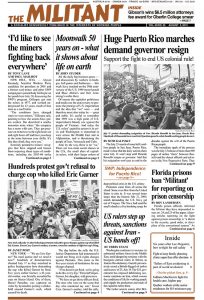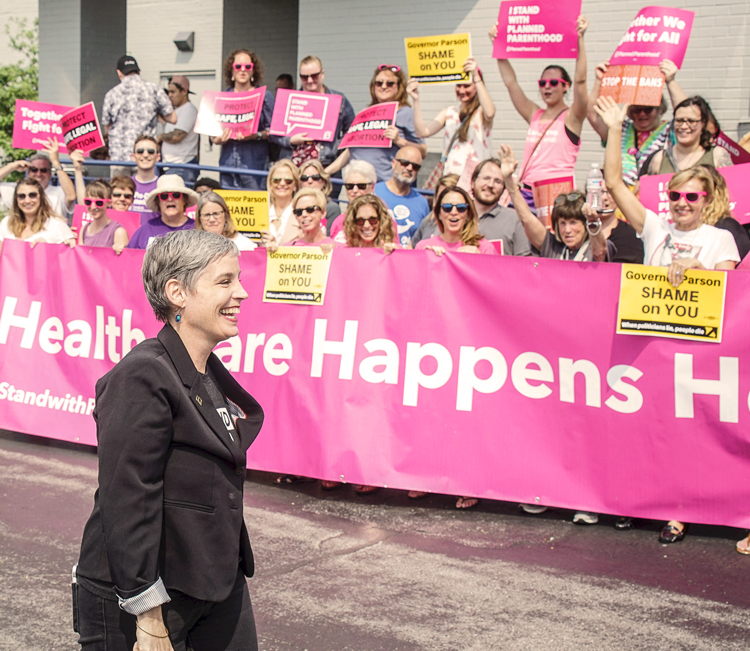In St. Louis, abortion rights supporters are fighting to keep open Missouri’s one remaining Planned Parenthood clinic, which provides family planning help, including abortion. Across the Mississippi River, Hope Clinic for Women in Granite City, Illinois, reports that 50% of all patients require financial assistance.
“One 30-year-old woman came to Hope because the wait at the Missouri clinic was so long that it would have put her past the 10-week mark, the latest point at which she could get her preferred method of care: a medication abortion, which involves pills, not surgery,” wrote the New York Times July 9. Five other states have only one clinic that provides abortions — Kentucky, Mississippi, North Dakota, South Dakota and West Virginia.
“Whenever states enact restrictions, the people who are most affected are the ones with the fewest resources,” Rachel Jones, a researcher at the Guttmacher Institute, which tracks statistics on women’s right to choose abortion, told the Times. The number of women obtaining abortions who are classified as living in poverty has doubled — from 25% in 1994 to 50% in 2014, Guttmacher reports.
Suffering the effects of today’s capitalist economic crisis, more working-class women are postponing marriage and child-rearing. The average age women in the U.S. have their first baby is climbing — at 26.3 years old in 2016 compared to 22.7 in 1980.
Regardless of the increasingly onerous restrictions on women’s right to choose to have an abortion — including closing down of clinics, “waiting periods” that require multiple visits, and legal bans on abortion at earlier points in a woman’s pregnancy — many working-class women fight their way to get the procedure.
Debate cut short prematurely
“Four decades ago, in the years following the 1973 Supreme Court decision Roe v. Wade, access to abortion looked very different,” the Times said. “Clinics opened, and within a decade an abortion was rarely over an hour’s drive away, other than in America’s more remote corners.”
Some 300,000 women annually applied for federal funds to have an abortion until 1976, when Congress passed the Hyde Amendment barring Medicaid funding. Since then, 76 independent groups, recognized by the National Network of Abortion Funds provide some aid, including for travel. But the “funds will never meet the actual need of people who need help,” Yamani Hernandez, the group’s executive director, told the media.
The 1973 Roe v. Wade ruling that legalized abortion was based on medical criteria — not on equal protection of the law guaranteed under the 14th Amendment to the U.S. Constitution. This has facilitated efforts of anti-abortion campaigners to pass hundreds of increasingly strict restrictions.
The court’s ruling also prematurely cut off the debate that was unfolding over abortion and women’s rights. This has led to confusion on the part of many people over why women need the unconditional right to family planning, including safe and secure birth control and abortion. Defending the right to choose is fundamental to a woman’s control of her own life, and to winning full social, economic and political equality, opening the door to strengthening the unity and fighting capacity of the working class.
This is reflected in the fact that today the majority of adults support the right to choose, but those who unconditionally support abortion rights are not the majority. In a Gallup poll in May, only 25% said it should be legal “under any circumstances.”
A federal appeals court ruled July 11 the White House could impose a “gag rule” for abortion referrals by family planning clinics that receive federal Title X funding. The program serves about 4 million women yearly, some 40% in clinics affiliated with Planned Parenthood.
While clinic workers could discuss abortion as an option, they could no longer provide a referral for the procedure. And starting next year family planning clinics would not be allowed to share physical space with abortion providers. The Health and Human Services Department announced July 20 that clinics would have two months to comply with the regulation.


